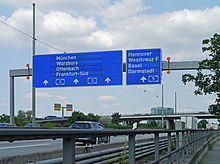
Traffic signs, installations, and symbols used in Germany are prescribed by the Road Traffic Regulation (StVO) (German: Straßenverkehrs-Ordnung) and the Traffic Signs Catalog (VzKat) (German: Verkehrszeichenkatalog).[1][2][3]
§§ 39 to 43 of the StVO regulate the effect of traffic signs and installations. Annexes 1 to 3 illustrate most danger, regulatory, and directional signs and annex 4 illustrates the traffic installations. Other traffic signs and installations not specified in the StVO, primarily specific supplementary signs, are published in the VzKat.[1]
The latest version of the VzKat was issued in May 2017[2] as the annex to the General Administrative Rules for the Road Traffic Regulation (VwV-StVO) (German: Allgemeine Verwaltungsvorschrift zur Straßenverkehrs-Ordnung).[4]
The StVO, the VwV-StVO and the VzKat are supported by technical rules (German: Technische Regelwerke), mostly published by the Forschungsgesellschaft für Straßen- und Verkehrswesen (FGSV), especially:
- The Guidelines for Directional Signage outside of Motorways (RWB[5][6]) (German: Richtlinien für die wegweisende Beschilderung außerhalb von Autobahnen)
- The Guidelines for Directional Signage on Motorways (RWBA[7][8]) (German: Richtlinien für die wegweisende Beschilderung auf Autobahnen)
- The Guidelines for touristic Signage (RtB[9]) (German: Richtlinien für die touristische Beschilderung)
- The Guidelines for Signage for detours (RUB[10][11]) (German: Richtlinien für Umleitungsbeschilderungen)
- The Guidelines for the Marking of Roads (RMS-1[12], RMS-2[13] and RMS-A[14]) (German: Richtlinien für die Markierung von Straßen)
- The Guidelines for Traffic Signals (RiLSA[15][16]) (German: Richtlinien für Lichtsignalanlagen)
- The Guidelines for the safety of road construction sites (RSA[17]) (German: Richtlinien für die verkehrsrechtliche Sicherung von Arbeitsstellen an Straßen)
All signs have assigned numbers. The suffix number after the hyphen refers to the variation of the sign; the suffix on signs with variable numbers is the number depicted on the sign (for speed limits, maximum heights, etc.).[2]
- ^ a b "Straßenverkehrs-Ordnung (StVO) § 39 Verkehrszeichen". Federal Ministry of Transport. Retrieved 18 August 2020.
- ^ a b c "VzKat 2017" (in German). 5 July 2020. Retrieved 18 August 2020.
- ^ "German Road Traffic Regulations (Translation)" (PDF). Retrieved 15 May 2024.
- ^ "Allgemeine Verwaltungsvorschrift zur Straßenverkehrs-Ordnung (VwV-StVO)". Retrieved 18 August 2020.
- ^ "RWB 2000". www.fgsv-verlag.de (in German). Retrieved 2023-10-11.
- ^ "RWB 2000 - Richtlinien für die wegweisende Beschilderung außerhalb von Autobahnen". www.verkehrsblatt.de. Retrieved 2023-10-11.
- ^ "RWBA 2000". www.fgsv-verlag.de (in German). Retrieved 2023-10-11.
- ^ "RWBA - Richtlinien für die wegweisende Beschilderung auf Bundesautobahnen". www.verkehrsblatt.de. Retrieved 2023-10-11.
- ^ "RtB". www.fgsv-verlag.de (in German). Retrieved 2023-10-11.
- ^ "RUB". www.fgsv-verlag.de (in German). Retrieved 2023-10-11.
- ^ "RUB 2021 - Richtlinien für Umleitungsbeschilderungen (RUB)". www.verkehrsblatt.de. Retrieved 2023-10-11.
- ^ "RMS-1". www.fgsv-verlag.de (in German). Retrieved 2023-10-11.
- ^ "RMS-2". www.fgsv-verlag.de (in German). Retrieved 2023-10-11.
- ^ "RMS - Teil A: Autobahnen". www.fgsv-verlag.de (in German). Retrieved 2023-10-11.
- ^ "RiLSA". www.fgsv-verlag.de (in German). Retrieved 15 May 2024.
- ^ "Guidelines for Traffic Signals" (PDF). Retrieved 15 May 2024.
- ^ "RSA 21". www.fgsv-verlag.de. Retrieved 15 May 2024. |language=de